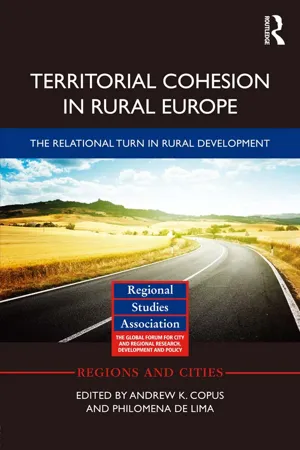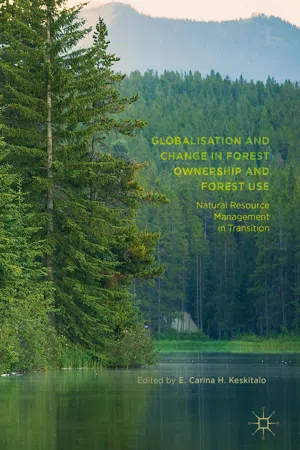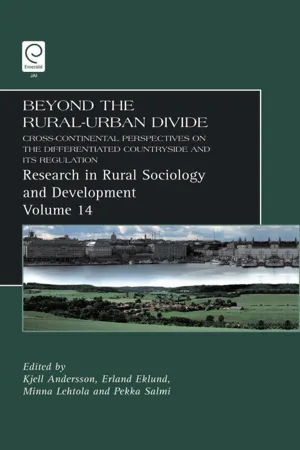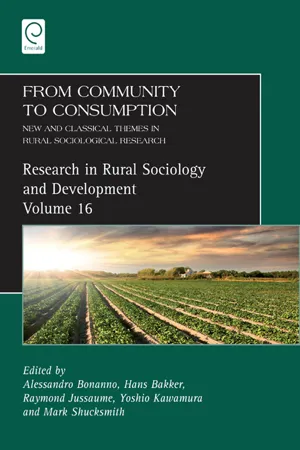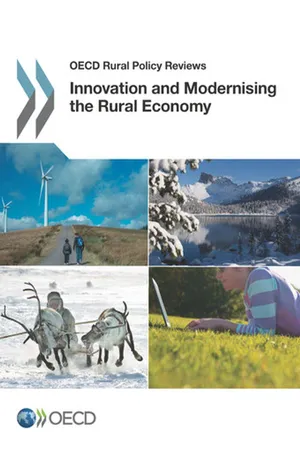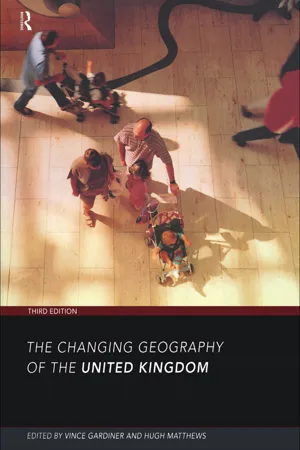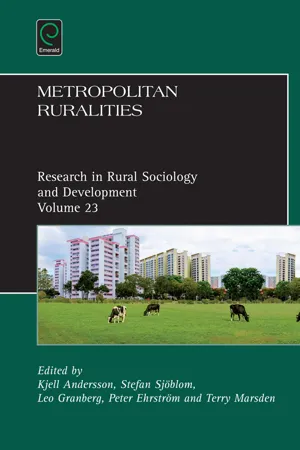Geography
Rural Change
Rural change refers to the transformation and evolution of rural areas over time. This can include shifts in population, economic activities, land use, and infrastructure. Factors driving rural change may include technological advancements, agricultural practices, urbanization, and government policies. Understanding rural change is important for analyzing the dynamics of rural communities and their interactions with the broader society.
Written by Perlego with AI-assistance
Related key terms
1 of 5
10 Key excerpts on "Rural Change"
- eBook - ePub
- Brian W. Ilbery, Brian Ilbery(Authors)
- 2014(Publication Date)
- Routledge(Publisher)
CHAPTER 1 DIMENSIONS OF Rural Change Brian IlberyINTRODUCTORY SETTING
Rural Change is multidimensional and the countryside in developed market economies can no longer be viewed as being on the margins of economic, social and political change. Indeed, rural areas are now at the centre of interest and debate (Rogers, 1993) and many of the processes of change stem from broader and more general socio-economic and political processes. As a consequence, policy makers are having to re-evaluate policies relating to ‘rural space’. The countryside is increasingly an area of consumption as well as production and the switch away from a productivist philosophy means that farmers and other primary producers are looking for new ways of generating income. Alternative uses of rural space are developing, and as Cloke and Milbourne (1992, p. 360) comment, ‘there is no longer one single rural space, but rather a multiplicity of social spaces that overlap the same geographical area’.This book is concerned with detailing and understanding the often complex processes and outcomes of change which have recently been experienced by rural areas in developed market economies. It emphasizes the spatial manifestations of Rural Change and provides up-to-date insights into different dimensions of rural restructuring, written by experts in their respective fields. Different theories, concepts and principles are outlined where relevant, but the book deliberately avoids adopting any one particular and overriding theoretical framework. Indeed, with the exception of the two theoretical chapters (Chapters 2 and 3 ), authors have been encouraged to develop their chapters in whatever they consider to be the most appropriate manner. Students need to be aware of this diversity of approach, which reflects the nature of debate in rural geography. The result is a book in which some chapters provide essentially empirical reviews of particular dimensions of Rural Change, whereas others develop a stronger theoretical component. In keeping with the general tenor of this diversity of approach, the book does not adopt any standard definition of either rural or rurality - eBook - ePub
Territorial Cohesion in Rural Europe
The Relational Turn in Rural Development
- Andrew Copus, Philomena de Lima(Authors)
- 2014(Publication Date)
- Routledge(Publisher)
et al. 2010).Some aspects of the changes that have been experienced by rural Europe might be described as outcomes of processes of ‘globalization’. Globalization as a concept, and the nature of its influence on societies, is highly contested (Held et al.1999, el-Ojeili and Hayden 2006). Although, in the recent dominant discourse, the concept has tended to be associated with large cities, there is, at the same time, considerable historical evidence of long-established international connections between rural areas (Peet 1969, 1972 , Wallerstein 1991). It may, therefore, be more helpful to describe what has happened to rural Europe as a ‘step change’ in the degree of interconnectedness and in the importance of linkages and flows (both rural-urban and rural-global). Such linkages take a variety of forms, including tangible flows of goods, services and people associated with economic transactions, migration and daily commuting, mobility associated with leisure and tourism, social interactions and communication involving flows of information and knowledge, and interactions between different levels of governance or institutions.In 1997, the economist Frances Cairncross published a book entitled, The Death of Distance -How the Communications Revolution Will Change Our Lives. In the same year, a French academic, Jean-Pierre Veltz, observed that the economic landscape was ‘no longer well ordered by distance’ and that, ‘the territory that counts is more and more the territory of social interaction, not merely of physical proximity’. Since then, a number of different schools of thought have developed, each with a different vocabulary, but each arguing basically the same thing: that economic and social life is becoming liberated from the costs associated with Euclidean distance, and that what is now important are various kinds of ‘relational proximity’. This, the argument goes, will revolutionize the way in which people, firms and institutions interact and, therefore, the way in which human activities are distributed across territories. In the words ofTallman et al - eBook - PDF
Globalisation and Change in Forest Ownership and Forest Use
Natural Resource Management in Transition
- E. Carina H. Keskitalo(Author)
- 2017(Publication Date)
- Palgrave Macmillan(Publisher)
To this end, the chapter offers not only exam- ples of conceptions of the rural from varying bodies of literature but also emphasises how historical developments of both rural infrastructures and national tax systems may play important roles in supporting rural areas. In this, it particularly utilises the Swedish case to illustrate the role of E.C.H. Keskitalo et al. 185 policy orientation and state context for rural development over time. In relation to this, the chapter problematises how changing forestry and broader rural employment structures may play a role in systems of sup- port for rural land uses. The Concept of the Rural and Rural Change The concepts of rural and rurality have been discussed over a long period of time. Even though most people have some kind of common under- standing of these concepts and frequently use them, many scholars have pointed out the difficulties in establishing definitions that can be agreed upon once and for all (Hoggart 1990; Halfacree 1993; Ilbery 1998; Woods 2011). Based on Halfacree (1993), Woods (2005) presents four broad approaches to the concept of rural but also illustrates some of the difficulties the various definitions entail. Descriptive definitions derive from an assumption that rural areas can be distinguished from urban areas based on their spatial and socio-demographic characteristics, for example, population density, size of settlement or occupational structure, or combinations thereof. One obvious problem is the arbitrariness of such crude measurements, that is, where to draw the line between urban and rural. Socio-cultural definitions attempt to identify the characteristics of rural societies and how they are different from urban ones, based on the behaviour and attitudes of people living in these societies. - Paul Cloke(Author)
- 2013(Publication Date)
- Taylor & Francis(Publisher)
The changes taking place in rural areas are complex and interconnected. Although a repopulation appears to be taking place in many areas, it is clear that problems generic to small remote settlements continue to be important and to require planning action. Given these rather complicated spatial manifestations of change, our understanding of rural trends is perhaps best enhanced by a view of the systematic forces which are sponsoring change in rural settlements.Agents of changeNo clear-cut and distinctive boundaries exist between the various forces which have prompted changes in rural settlements and communities. Change has come from a series of interrelated factors imposed on a sparsely populated settlement structure. This has created an impetus for change which is greater than the combined influence of the individual components. Nevertheless five broad agents of change may be isolated which contribute to the overall processes of dynamism in rural settlements, and to these is added the factor of inertia which has perhaps prevented positive changes and indirectly promoted somewhat more harmful trends.Decline in traditional labour forces
A fundamental instigating process in Rural Change has been the wholesale decline in traditional forms of rural employment. This trend has been well documented (Ministry of Agriculture, Fisheries and Food, 1967; Chisholm and Oeppen, 1973) and is so established a phenomenon that Kotter (1962) was able to describe it as an inevitable process in the development of a civilized economy. In 1750, 75 per cent of Britain's population was employed on the land. By 1801, census material reveals that this proportion had decreased to less than 50 per cent and by 1951 a mere 20 per cent of the population was employed in agriculture. Today the figure has fallen to around 2 per cent although another 8 per cent are employed in ancillary and support trades mainly based in urban locations. Farming, however, has never been the only source of employment for the rural labour force. The primary employment in farming, forestry and quarrying was traditionally balanced by a profusion of secondary small craft and consumer industries, and in fact it was this industrial element of the rural economy which was first to suffer from technical development (in this case the development of urban-based industry in the Midlands and the North). Bonham-Carter (1976, 28) paints a vivid image of rural craft industry ‘flickering out like the flame of a dying candle all through the nineteenth century’.- eBook - PDF
Beyond the Rural-Urban Divide
Cross-Continental Perspectives on the Differentiated Countryside and Its Regulation
- Kjell Andersson, Erland Eklund, Minna Lehtola, Kjell Andersson, Erland Eklund, Minna Lehtola, Terry Marsden(Authors)
- 2009(Publication Date)
- Emerald Group Publishing Limited(Publisher)
These systems rely on indicators such as population size, density, and accessibility, however, and remain even if they can be combined with impressive GIS, technology and lack the explanatory power once connected with the rural–urban dichotomy. Thus, these systems have gained little attention outside expert circles. We believe that new classification systems must be explanatory and, instead of producing mere geographical and demographi-cal descriptions, must address the processes behind the observed changes from economic as well as cultural and political points of view. These are high ambitions, but the chapters included in this volume aim to contribute, if only in small part, to the hitherto rather unfocused debate. However, rural–urban change is neither random nor globally uniform but is instead often path-dependent; the chapters here provide some insight into this topic. Introduction: Beyond the Rural–Urban Divide 7 A cultural change involving a loosening of the traditional ties between culture and determinants, such as geographical areas, is also one of the facets of contemporary rural–urban development; some chapters hint at this topic as well. The same holds true for the ‘‘flows’’ more or less constituent of late modern rural–urban areas. Lastly, current rural–urban areas exhibit a mix of different groups and views; this same mix is more or less the raison d’etre for the new horizontal governance practices discussed in several chapters. Thus, we trust that the chapters not only shed light on the discussion above, but also provide material for a deepening of this discussion. DIFFERENTIATION PROCESSES In the first part of the volume, which focuses on differentiation processes, in Chapter 1 Olli Lehtonen and Markku Tykkyla ¨inen observe two somewhat temporarily different, but at the same time closely related, processes. - eBook - PDF
From Community to Consumption
New and Classical Themes in Rural Sociological Research
- Alessandro Bonanno, Hans Baker, Raymond Jussaume, Yoshio Kawamura, Mark Shuksmith, Terry Marsden(Authors)
- 2010(Publication Date)
- Emerald Group Publishing Limited(Publisher)
However, this apparent exclusion of rural communities from these large capital movements is contested. Empirical evidence regarding the status of these communities in the process of building new sustainability and rurality models are challenging the new North/South relationships. Analysis of the different processes of new ruralities and urbanization aspects promoted by the expansion of cultivations that affect the rural livelihoods of the involved populations should be undertaken. The implementation of environmentally healthy practices and the provision of spaces and natural amenities, ‘‘sources of energy and biodiversity,’’ promote a super valorization or reinvention of these communities (Lash & Urry, 1994, p. 316) as promoters of quality of life and a healthier environment. RURAL COMMUNITY MEANINGS AND RELEVANCE FOR A PROSPEROUS FUTURE The differences and inequalities that expand with the globalization process, accentuated in their aspects of culture, gender, ethnicity, nation, religion, generation and the context of labor through specializations, qualifications and restricted access to labor markets, technology and knowledge must be considered ( Long, 1996, p. 37 ). It is essential to inquire about the impact of these conditions in the course of subjects and communities they are bound to, Rural Community in a Globalizing World 135 in specific conjunctures and historical contexts, which is an economy of signs and spaces (Lash & Urry, 1994; Silva, 1999 ; Sigaud, 1992 ) in which the mobility and the permanent itinerancy of the subjects are registered. The social movements that emerged in the three past decades of the 20th century ( Scherer-Warren, 1984 ) set the ground for contending how unsustainable the adopted development models were and still are. The green movements and those of fighting for the land and other natural resources signaled critical issues related to the use of the environment, water, and labor. - eBook - PDF
- OECD(Author)
- 2014(Publication Date)
- OECD(Publisher)
In rural areas, innovation is driven because people need to innovate to capture external markets or to ensure that basic services are provided. Rural innovation is also about entrepreneurship, that is, taking new ideas and transforming them into new markets, products and services. Rural areas can be a fertile ground for social innovation and social entrepreneurship, which brings local social capital together to provide missing services or to profit from local assets with a social purpose. Economic growth happens when innovations are applied and diffused. Understanding how innovation can happen in rural areas and finding ways to foster it is central to modernising the rural economy. Innovation is just as vital for rural economies as it is for the economies of cities: both for raising productivity and for meeting the challenges of improving public service delivery. As recent research shows, innovation is a key factor in promoting growth, and lack of innovation is a bottleneck for growth (Table 2.1) (OECD, 2012a). A region’s capacity to innovate, its resilience to shocks and the efficiency with which it delivers services all relate to the stock and quality of human capital in its workforce. It is hard to imagine a region engaging in a sustained path of technological improvement without an abundant supply of skilled labour. Table 2.1. Factors and bottlenecks for growth Thematic areas Growth factors ranked Bottlenecks ranked 1 Policies 13 13 2 Human capital 12 11 3 Innovation 7 13 4 Infrastructure connectivity 11 8 5 Institutions 8 9 Source: OECD (2012), Promoting Growth in All Regions , OECD Publishing, Paris, http://dx.doi.org/10.1787/9789264174634-en . Drabenstott and Henderson (2006) identify two elements as pivotal to any rural development strategy: i) the “twin forces of innovation and entrepreneurship”, and ii) “a critical mass of human, financial and social capital to support evolving innovative and entrepreneurial activity”. - eBook - ePub
- Hugh Matthews, Vince Gardiner(Authors)
- 2002(Publication Date)
- Routledge(Publisher)
Chapter 11Rural Change and development
Malcolm Moseley
Introduction
The first problem with rural Britain is to define it. Indeed, the first task is to question its existence altogether! That statement is not an excuse for bemoaning the so-called fact that our leafy shires are rapidly disappearing under a tidal wave of concrete—a much exaggerated bit of scaremongering—but merely a recognition that although nine-tenths of our island is still visually ‘countryside’, in social and economic terms the distinctiveness of ‘rural Britain’ is fast disappearing. Our island is shrinking, as much because of advances in telecommunications as because of those in transport availability, and the argument that most of midland and southern England is now one vast dispersed metropolis, whatever the view from the window, is now a compelling one.But ‘rural areas’ —however defined—do have certain characteristics, notably low population density and a much sought after green environment, which give national social and economic trends and problems a peculiar twist when they surface in that milieu. It is those ‘twists’ to which this chapter will be devoted. Look in other chapters if your interest is predominantly in that minority but necessarily rural industry called agriculture (Chapter 5 ), in land use per se (Chapter 20 ), or in the physical environment of the countryside (Chapters 17 and 20 ).As for a definition, the criteria most commonly used are population density, the proportion of built-upon land, remoteness from urban centres, and degree of reliance upon ‘land extensive’ economic activities (notably agriculture, horticulture, forestry, quarrying, fishing, environmental management, green tourism and outdoor recreation). But every researcher applies such criteria in a different way (how remote is ‘remote’?; what density is ‘low density’?) and data availability imposes its own complications. In short, there is no unambiguous domain called ‘rural Britain’. - Elena Milanova, Yukio Himiyama, Elena Milanova, Yukio Himiyama, Elena Milanova(Authors)
- 2005(Publication Date)
- CRC Press(Publisher)
They often have complicated shapes and are small in size. The largest plots used to be concentrated next to settlements and roads. Natural fodder plots (pastures and hayfields), earlier at highly inconvenient for development sites (gullies, ravine heads, steep slopes, forest glades), by now have moved to floodplains and poorly drained flat parts of interfluves. In the early 1990s, drastic increase in settlement areas occurred, when dacha construction livened up and adjacent farmlands were involved, allowing seasonal and local residents to extend their personal subsidiary plots. As a result, land-use activity grew significantly in areas of early CHANGE IN LAND COVER AND CULTURAL LA NDSCAPES IN R U SSIA 1 0 5 low intensity in usage, such as slopes of 5° and greater grades. Nevertheless, the constant population of many rural settlements still decreased (Table 7.2). Conclusion In spite of numerous transformational changes in political and economic structures at state and local levels (mainly in structure of farming and arable lands) within the study period, the following stable changes in cultural landscapes have to be noted: a) forest area increased (by 2 times in the study period); b) arable land share decreased (by 2 times in 250 years); c) meadow share decreased (by 3 times); d) total settlement areas increased (over 2 times) along with technogenic relief area (quarries, road embankments, etc.), while constant rural population decreased (by 4 times in the last 150 years). Human economic activity is the main factor responsible for the transformation of land-use structure. Relatively slow natural agents realized themselves in long-term periods (about 10 years) of directional activity only. However, within periods of reducing anthropogenic impact or frequently changing economic policy, the role of natural processes increased, often becoming the key factor in determining local land use.- eBook - PDF
- Kjell Andersson, Stefan Sjöblom, Leo Granberg, Peter Ehrström, Terry Marsden, Kjell Andersson, Stefan Sjöblom, Leo Granberg, Peter Ehrström, Terry Marsden, Terry Marsden(Authors)
- 2016(Publication Date)
- Emerald Group Publishing Limited(Publisher)
The concept of different countrysides 12 arose: rural living places were becoming different, the countryside supplied urban consumers a lei-sure time environment with harmonious nature and experiences of farm life. Often, countryside was understood in a neo-romanticist way as the space with aesthetic landscape, authentic nature and true country life. This kind of rural development was beyond the horizon of critical research, firstly, because rural development needed practically oriented research to assist rural policy programs, and secondly, because critical research mostly operated with concepts of agricultural sociology 13 77 Rural Research from Combating Poverty to Sustaining Ecosystems while rural policy had its focus on local society, villages and communities, as well as in local governance. Environmental themes multiplied among agricultural sociologists and rural researchers since the 1970s ( Buttel, Larson, & Gillespie, 1990 ). At the turn of the Millennium, various issues connected to climate change were added to this problem area. A set of new topics emerged, which has a rela-tion to spatial rural À urban dimension, but which is not easily connected to rurality on its old terms. Development of an independent area of environ-mental studies has pushed rural research to a crossroad with a dilemma, whether to leave this focus to others or to integrate it in the rural research agenda in one way or another. This question is taken up later with the sug-gestion to move the focus in rural research towards ecological issues and to accept ecosystem services as a concept, which might promote a renewal of rural research. (d) Evolution of Research Institutes The main choice in organising rural research was between academic scienti-fic institutes and institutes with practical aims to develop agriculture or countryside in general. Europe followed mainly the first path and the United States the second.
Index pages curate the most relevant extracts from our library of academic textbooks. They’ve been created using an in-house natural language model (NLM), each adding context and meaning to key research topics.

